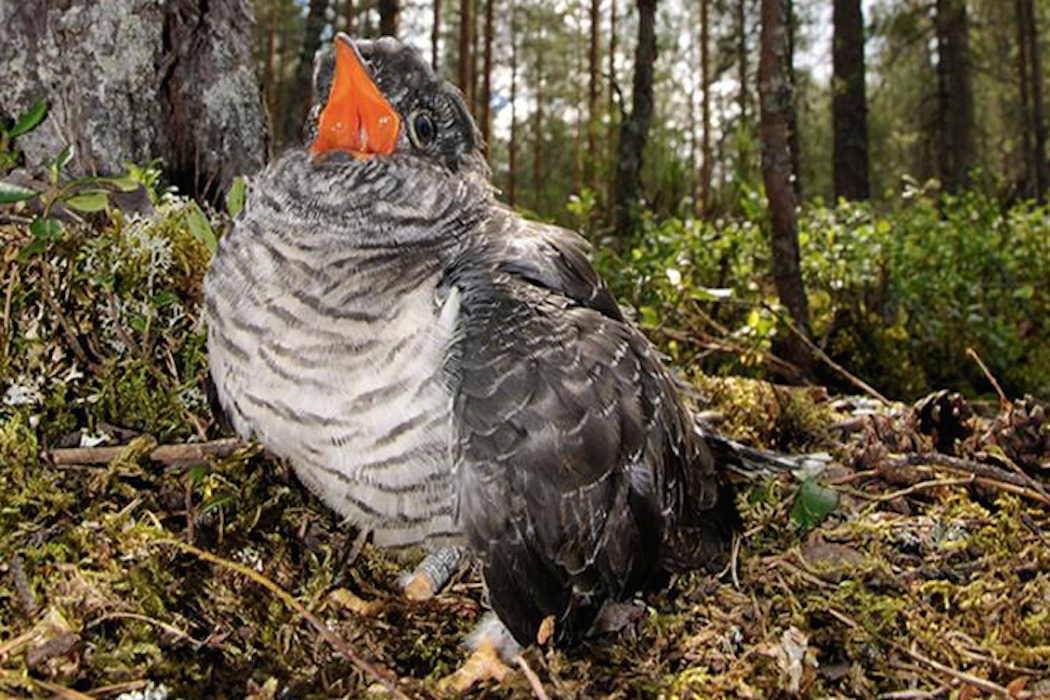Watch out, Alaskan songbirds, the Russian cuckoos are coming! And they are sneaky tricksters.
Cuckoos are brood parasites. Unlike most other bird species, cuckoos don’t raise their chicks themselves. They lay their eggs in the nests of other birds, and neither incubate nor feed their hatchlings, leaving them to depend entirely on other species for survival. Although cuckoos may target many different types of birds, most tend to focus on one host or a group of hosts that have eggs of similar appearance—to avoid detection. For example, common cuckoos lay pale blue eggs that resemble the eggs of redstarts, which are one of their typical targets. “The egg color is genetically determined,” explains Mark Hauber, animal biologist at the University of Illinois—and the cuckoos can evolve new mutations to alter the color of the eggs.
Cuckoos also time their egg-laying so that their chicks hatch first. Then, the freshly hatched little parasites lose no time in eliminating competition: They kill their adoptive parents’ brood by pushing the eggs out of the nest. If the eggs manage to survive until hatching, they push their “siblings” out of the nest too. Cuckoos are so deft at this trick that they can completely disrupt the reproductive cycle of their hosts.
It seems that common cuckoos and oriental cuckoos are expanding their breeding range from eastern Russia into western Alaska. They have been likely coming from an area in Eastern Russia called Beringia. While still a rarity in Alaska, birdwatchers and ornithologists have occasionally spotted these species, and fear their invasion could be quite devastating to the native songbirds who are not familiar with their reproduction schemes. “We don’t have evidence of them breeding in Alaska,” Hauber says, “but it’s likely already occurring.”
Birds who coexist with parasitic avian species have evolved defenses to counteract their ways, Hauber says. “There are strategies such as hiding your nest, nesting at a time when the brood parasite is not around, or attacking the brood parasite when it is in proximity to your nest,” Hauber says. “If that doesn’t work, you can abandon the nest with a cuckoo egg in it.”

So what would Alaskan songbirds do, given their naiveté with the Russian cuckoo tricks? Hauber and his colleague Vladimir Dinets at the University of Tennessee, Knoxville, wanted to test how Alaskan songbirds would act. “We wanted to know whether the potential Alaskan hosts are ready for this cuckoo invasion,” Hauber says.
To find out, the researchers put fake eggs in the nests of over two dozen different bird species nesting in Siberia and Alaska. The fakes were either pale blue, mimicking the eggs of the redstarts, targeted by common cuckoos, or light gray-blue with brown spots, mimicking the eggs of pipits, often targeted by common cuckoos and oriental cuckoos.
It turned out that Siberian birds were much better than their Alaskan counterparts at sassing out the foreign eggs. “Out of 22 experiments that we ran in Siberia, 14 rejected the fake cuckoo eggs,” Hauber said. “But out of the 96 experiments that we ran in Alaska, only one pair rejected one of the fake cuckoo eggs.”
It’s likely because the Siberian birds have had experience with the cuckoos and learned their tricks. Other birds have done it too. “In Japan, when the cuckoos switched to another previously unused host, in 20-30 years, they evolved egg rejection responses,” Hauber says. But small, isolated populations are the most vulnerable to such invasions—and in Alaska several potential hosts fit the bill. “[They] have no defenses against invading cuckoos,” Hauber says. They are in for some tough times, and their numbers may dwindle. “So this is a true risk.”







